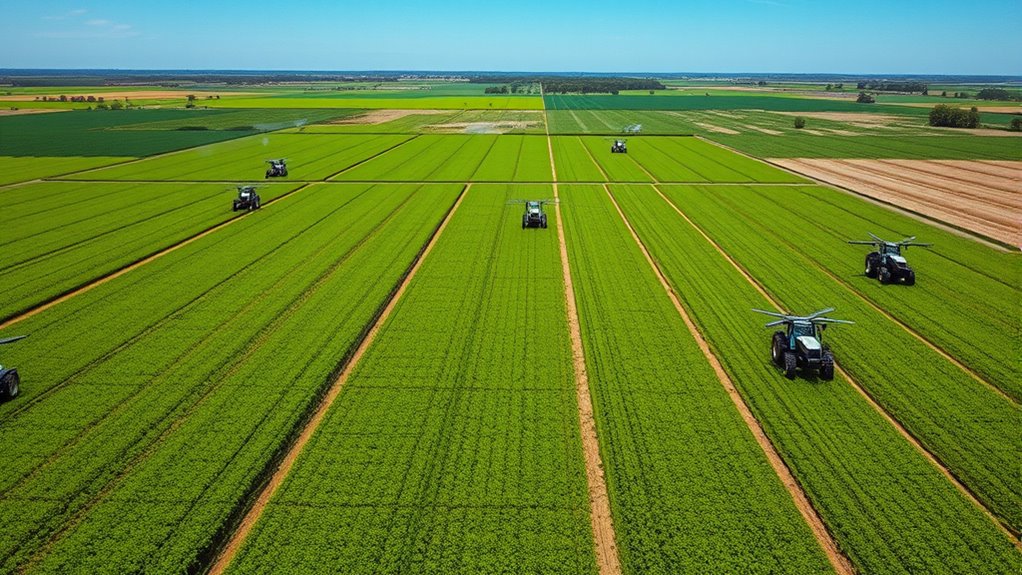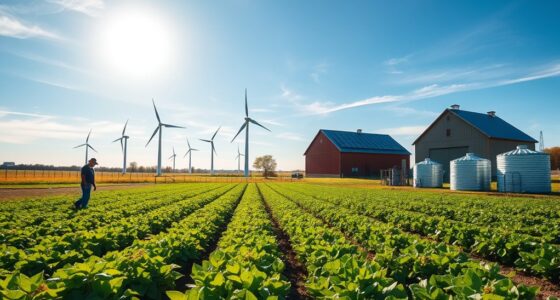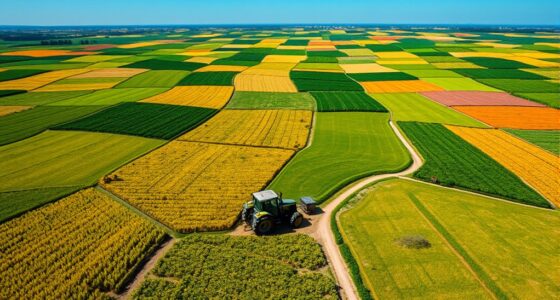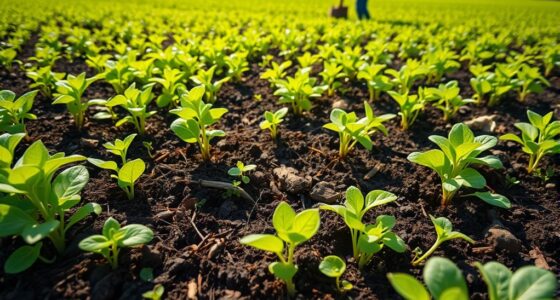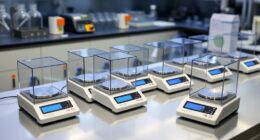Precision agriculture technologies are revolutionizing how you manage crops by integrating GPS-guided machinery, sensors, remote sensing, and autonomous equipment. These tools help you optimize resource use, improve yields, and enhance sustainability. Drones and satellite imagery offer real-time crop monitoring, while advanced data analytics and climate tools aid decision-making. By adopting these innovations, you’ll increase efficiency and reduce environmental impact. Keep exploring to discover how these cutting-edge solutions can transform your farming practices.
Key Takeaways
- GPS-guided machinery ensures precise navigation, planting, and resource application, reducing overlaps and increasing efficiency.
- Soil and crop sensors provide real-time data for informed decision-making and targeted field management.
- Drone surveillance and satellite imagery enable early detection of pests, diseases, and water stress across large areas.
- Autonomous equipment and robotics automate tasks like planting, weeding, and harvesting, improving productivity and reducing labor costs.
- Advanced data analytics and integrated software platforms optimize resource use, support sustainability, and enhance crop yield predictions.
GPS-Guided Machinery and Its Impact on Field Operations

Have you ever wondered how modern machinery can navigate fields with pinpoint accuracy? GPS-guided machinery makes this possible, transforming field operations. Automated planting relies heavily on precise machinery calibration, ensuring seeds are sown at exact locations and depths. This technology reduces overlaps and skips, optimizing seed placement and boosting yields. With accurate GPS data, you can program machinery to follow specific paths, minimizing human error. Machinery calibration becomes essential, aligning equipment settings with GPS inputs for flawless operation. Proper machine calibration ensures optimal performance and crop outcomes. Additionally, integrating tuning options such as engine and suspension adjustments can further enhance machinery efficiency and durability. Ultimately, GPS-guided machinery enhances efficiency, reduces waste, and improves crop management, making modern farming more precise and productive than ever before.
Drone Surveillance and Aerial Imaging for Crop Monitoring
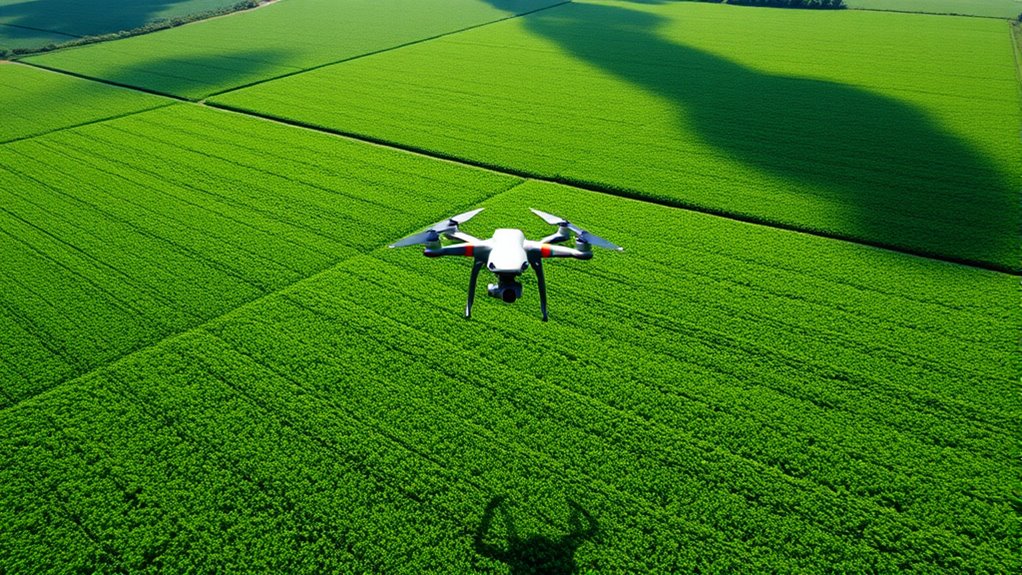
Drone surveillance and aerial imaging have become essential tools in modern crop monitoring, providing farmers with real-time, high-resolution data about their fields. With aerial photography, you can quickly identify issues like pest infestations, nutrient deficiencies, or water stress. Drones make crop scouting faster and more accurate, reducing the need for manual inspections. You can:
- Detect early signs of disease or pest outbreaks
- Monitor crop health across large areas
- Track growth patterns over time
- Assess damage after weather events
- Optimize resource application with precision
- Incorporate Halloween-themed drone displays into fall celebrations to showcase technology and creativity.
Additionally, advancements in contrast ratio technology improve the clarity and detail of aerial images, making it easier to interpret crop conditions from above. Utilizing industry trend insights can help farmers stay ahead of emerging challenges and adopt innovative solutions more effectively.
Soil and Crop Sensors Enhancing Data Collection Accuracy

Soil and crop sensors are transforming data collection by providing precise, real-time insights directly from the field. To guarantee reliable data accuracy, proper sensor calibration is essential; it guarantees that readings reflect actual soil and crop conditions consistently. Regular calibration helps you avoid errors caused by sensor drift or environmental factors, maintaining high data quality. These sensors measure critical parameters such as moisture levels, nutrient content, and temperature, delivering detailed information that supports informed decision-making. As a result, you can pinpoint specific needs within your fields, reducing guesswork and optimizing management practices. The combination of accurate calibration and high-quality sensors empowers you to gather trustworthy data, ultimately enhancing crop health and maximizing yields through more precise, data-driven interventions. Additionally, understanding how floating on water techniques can influence moisture management may provide further benefits in certain agricultural settings. Employing sensor maintenance routines ensures long-term accuracy and durability of your equipment, further supporting reliable data collection. Proper sensor calibration also helps in identifying potential malfunctions early, preventing costly errors and ensuring continuous data accuracy.
Variable Rate Technology (VRT) for Precision Input Application

Building on precise data collection from sensors, Variable Rate Technology (VRT) allows you to apply fertilizers, pesticides, and water at different rates across your fields. This targeted input application helps optimize resource use, reducing waste and increasing crop yields. With VRT, you can customize input rates based on soil variability, crop needs, and growth stages. It’s like giving each part of your field exactly what it needs, when it needs it. Decluttering your data management processes can further enhance operational efficiency and decision-making. Incorporating data-driven decision-making tools can improve the accuracy of input application and support sustainable farming practices.
Data Analytics and Farm Management Software Integration
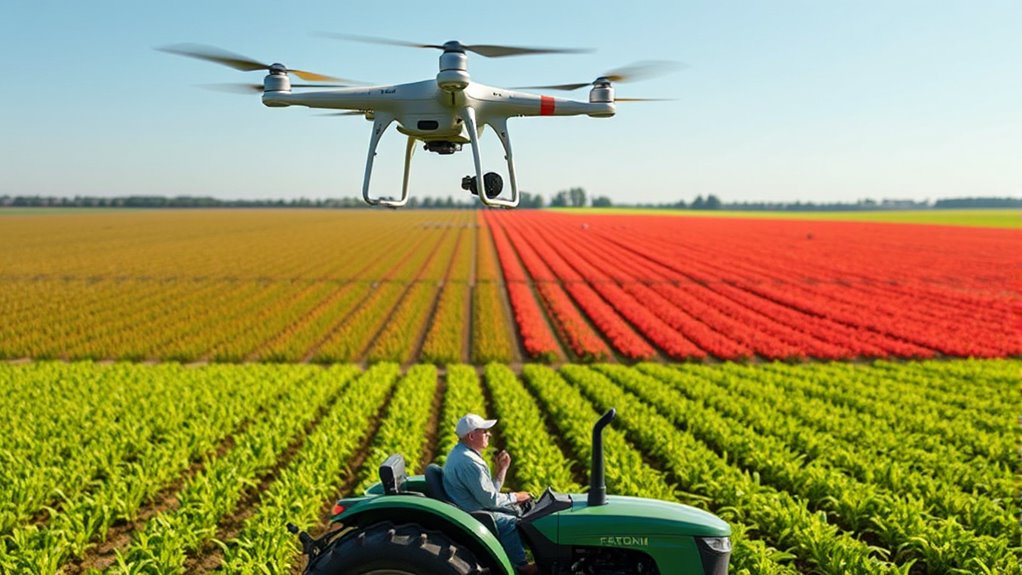
By integrating data analytics with farm management software, you gain real-time insights that bolster your decision-making. These tools help you monitor field conditions instantly and respond quickly to changing needs. Seamless software integration guarantees all your data works together smoothly for more efficient farm management. Additionally, understanding emotional support can be crucial when managing stress associated with technological transitions and ensuring a supportive environment for farm staff. Recognizing the importance of vendor reliability can help mitigate potential risks associated with adopting new technologies.
Real-Time Data Monitoring
Real-time data monitoring has become a crucial component of precision agriculture, enabling you to make immediate decisions based on current field conditions. By continuously collecting data from sensors, you can quickly respond to issues like soil moisture or pest presence. To guarantee accuracy, sensor calibration is essential, preventing misleading readings. Additionally, data security safeguards your sensitive information from cyber threats. Here are some key points to contemplate:
- Regular sensor calibration guarantees precise data collection
- Protect your data with robust security measures
- Use farm management software for seamless data integration
- Monitor fields continuously for timely interventions
- Leverage real-time insights to optimize resource use
- Data integrity is vital for reliable decision-making and maintaining trust in your monitoring systems. Ensuring sensor longevity through proper maintenance further enhances data reliability and reduces downtime. Incorporating cybersecurity protocols helps defend against potential cyber threats targeting farm data.
Implementing these practices helps you stay informed and responsive, maximizing crop health and yield.
Enhanced Decision-Making Tools
Enhanced decision-making in precision agriculture relies heavily on data analytics and farm management software integration, which transform raw sensor data into actionable insights. By analyzing soil fertility data, you can identify nutrient deficiencies and optimize fertilization schedules, improving crop yields. These tools also help you monitor pest populations and predict infestations, enabling targeted pest control measures that minimize chemical use. With integrated software, you gain an all-encompassing view of your farm’s conditions, allowing you to make informed decisions quickly. This approach reduces waste, saves costs, and enhances productivity. Additionally, the use of advanced analytics helps detect emerging threats early, allowing for proactive management. Ultimately, leveraging advanced analytics and management platforms empowers you to refine practices, respond proactively to issues, and achieve sustainable, high-quality crop production.
Seamless Software Integration
Integrating data analytics with farm management software creates a unified platform that simplifies decision-making and streamlines operations. This seamless integration enhances data interoperability, allowing different systems to communicate effortlessly. With edge computing, you can process critical data locally, reducing latency and improving real-time responses. Additionally, leveraging remote hackathons can accelerate the development and deployment of innovative farm management solutions.
Remote Sensing and Satellite Imagery in Crop Assessment
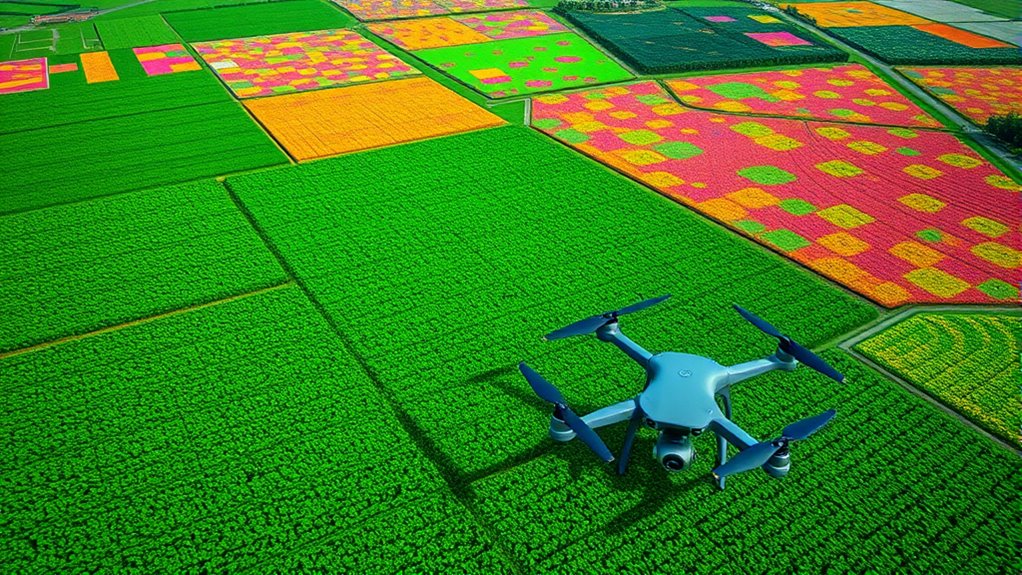
Remote sensing and satellite imagery enable you to gather data on your crops quickly and accurately. You can monitor crop health across large areas, identifying issues early before they spread. This technology also helps you make precise yield estimates, optimizing your harvest strategies. Additionally, integrating survival gear considerations into your planning can help ensure resilience in unpredictable conditions. Understanding Gold IRA options can also provide a secure financial foundation to support your farm operations during economic fluctuations. Moreover, staying informed about crop monitoring tools can enhance your ability to respond effectively to evolving environmental challenges.
Satellite Data Acquisition
Satellite data acquisition plays a crucial role in modern crop assessment by providing timely and accurate information about field conditions. With satellite imagery, you can monitor soil moisture levels and track crop phenology stages effectively. This data helps you identify drought stress, optimize irrigation, and schedule planting or harvesting activities. You’ll gain insights into how crops develop over time, enabling better decision-making.
Some key benefits include:
- Detecting variations in soil moisture across fields
- Monitoring crop growth stages precisely
- Spotting early signs of stress or disease
- Improving resource allocation and efficiency
- Enhancing yield predictions through detailed imagery
Crop Health Monitoring
By using satellite imagery and remote sensing technologies, you can effectively monitor crop health across large fields in real-time. These tools help identify areas suffering from soil compaction, which can restrict root growth and water absorption, allowing you to target management practices precisely. Satellite data also enables early pest detection by revealing abnormal vegetation patterns that suggest infestations. This rapid identification helps prevent crop damage and reduces the need for blanket pesticide applications. With frequent updates, you gain an all-encompassing view of your fields’ overall health, making it easier to prioritize interventions. Understanding soil conditions through remote sensing allows for more precise management decisions. Additionally, incorporating precision agriculture techniques can lead to more efficient use of inputs, reducing costs and environmental impact. For example, integrating tuning strategies into crop management can optimize equipment performance and resource application. By integrating satellite imagery into your crop management, you improve decision-making, optimize resource use, and enhance crop yields while minimizing environmental impact.
Precision Yield Estimates
Have you ever wondered how farmers can accurately predict crop yields before harvest? Remote sensing and satellite imagery make this possible by providing detailed, real-time data on crop conditions. This technology helps assess factors like plant health, soil moisture, and growth patterns, which influence yields. With genetic modification, crops become more resilient, reducing pest problems and improving yield estimates. Satellite imagery also aids in pest control by identifying infestations early, preventing crop loss.
Some key benefits include:
- Precise measurement of crop density
- Monitoring crop development stages
- Detecting pest outbreaks quickly
- Optimizing genetic modification strategies
- Improving overall yield predictions
These advances empower you to make smarter decisions, maximizing harvest potential while minimizing resource waste.
Autonomous Equipment and Robotics in Agriculture

How are autonomous equipment and robotics transforming modern agriculture? You’re at the forefront of this shift. Autonomous equipment, like self-driving tractors and drones, handle tasks with minimal human input, increasing efficiency and precision. Robotics applications enable you to perform planting, weeding, and harvesting more accurately and faster than ever before. These technologies reduce labor costs and improve crop yields by ensuring consistent operations. You can monitor fields in real time, identify issues early, and act swiftly. Robotics also help minimize chemical use by targeting specific areas, promoting sustainable practices. As these innovations evolve, you’ll find yourself managing your farm more effectively, making data-driven decisions that boost productivity and crop quality. Autonomous equipment and robotics truly reshape how you approach crop management.
Weather Forecasting Tools and Climate Adaptation Strategies

As climate variability becomes more unpredictable, utilizing advanced weather forecasting tools is essential for making informed decisions. These tools help you monitor changing weather patterns and adapt your crop management strategies accordingly. By integrating real-time data, you can better anticipate frost, droughts, or heavy rainfall, reducing crop loss and optimizing resource use. To boost your climate resilience, consider:
- Using satellite imagery for precise weather predictions
- Implementing soil moisture sensors for irrigation planning
- Tracking long-term climate trends with predictive analytics
- Coordinating planting schedules based on forecast accuracy
- Preparing contingency plans for extreme weather events
These strategies enable you to respond proactively to climate challenges, safeguarding your crops, and improving overall farm productivity. Embracing weather forecasting tools makes your operations more resilient and sustainable in an era of changing weather patterns.
Benefits of Precision Agriculture for Sustainability and Resource Conservation
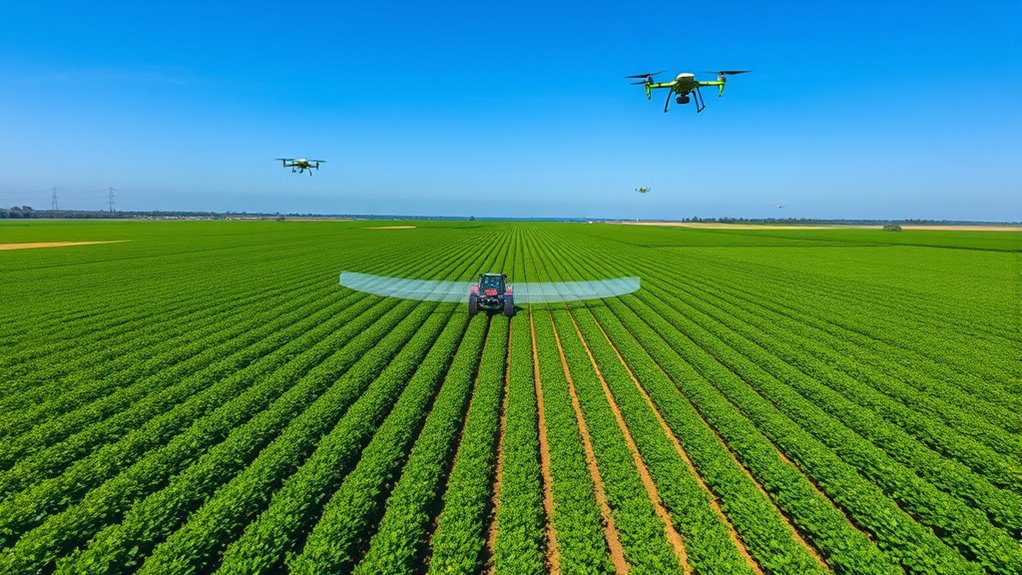
With precision agriculture, you can cut down on resource waste by applying water, fertilizers, and pesticides only where they’re needed. This approach not only conserves valuable resources but also minimizes environmental impact. Ultimately, it helps you become a better steward of the land while maintaining productive and sustainable farming practices.
Reduced Resource Waste
Precision agriculture markedly reduces resource waste by enabling you to apply water, fertilizers, and pesticides only where and when they’re needed. This targeted approach boosts water conservation and enhances energy efficiency, saving you money and reducing environmental impact. By avoiding over-application, you prevent runoff and pollution, keeping resources in balance.
Consider these benefits:
- Minimized water usage, supporting water conservation efforts
- Reduced energy consumption from fewer machinery runs
- Precise fertilizer application prevents waste and runoff
- Less pesticide use lowers chemical waste and environmental harm
- Overall resource efficiency improves your sustainability efforts
With these practices, you use resources more wisely, supporting long-term farm productivity and environmental health. Precision agriculture helps you waste less, conserve more, and operate more sustainably.
Enhanced Environmental Stewardship
Adopting precision agriculture practices substantially enhances your ability to protect and preserve the environment. By using GPS-guided equipment and data analysis, you can optimize input application, reducing runoff and soil erosion. This promotes soil conservation, maintaining land productivity for future generations. Precision methods also help you target specific areas, minimizing unnecessary disturbance and supporting habitat preservation. As a result, you foster healthier ecosystems, protect local wildlife, and sustain biodiversity. These practices encourage responsible resource use, lowering energy consumption and decreasing chemical use, which benefits water quality and air purity. Overall, precision agriculture empowers you to implement more sustainable farming techniques, aligning productivity with environmental stewardship and ensuring the long-term health of your land and surrounding habitats.
Future Trends and Innovations in Crop Management Technologies
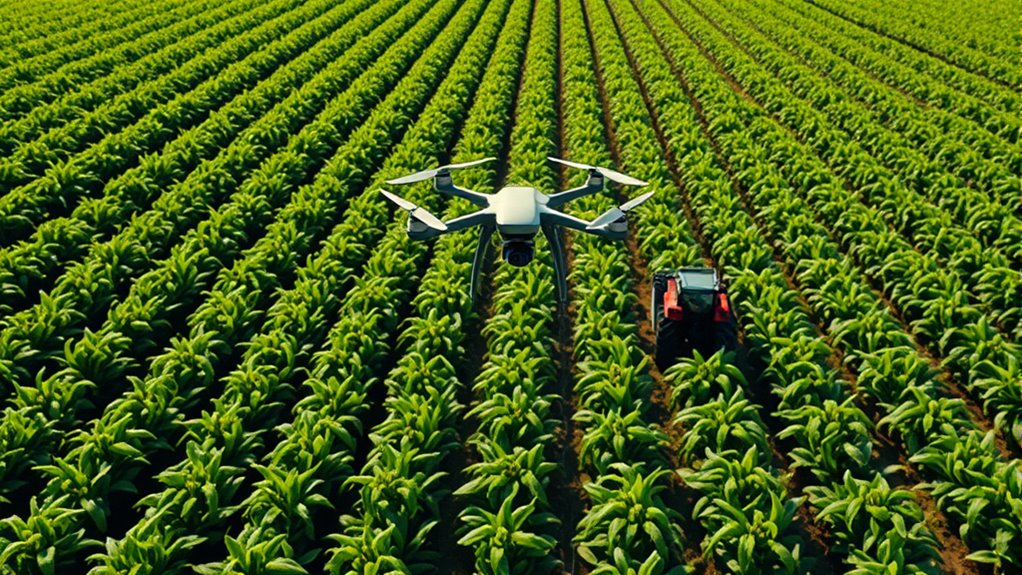
As technology continues to advance, crop management is poised to become more efficient and sustainable through innovative solutions. Future trends focus on integrating urban farming with high-tech tools, making city-grown food more viable. Expect smarter sensors and AI-driven analytics to optimize organic crop varieties, reducing waste and boosting yields. Precision drones will monitor crop health in real time, even in tight urban spaces. Vertical farming will leverage automation for consistent production. Additionally, sustainable practices like soil-less cultivation and water recycling will gain prominence. Here’s what’s next:
- Urban farming expanding with IoT integration
- Greater adoption of organic crop varieties
- AI-powered pest and disease detection
- Autonomous farming machinery
- Real-time data for tailored crop management
Frequently Asked Questions
How Cost-Effective Are Precision Agriculture Technologies for Small-Scale Farmers?
You might wonder if precision agriculture technologies are worth it for small-scale farmers. While the initial investment can be high, you can experience significant cost savings over time through improved resource use and increased yields. These technologies help you optimize inputs like water, fertilizer, and pesticides, reducing waste. Ultimately, they can be cost-effective if you carefully assess your farm’s needs and long-term benefits, making them a smart choice.
What Are the Cybersecurity Risks Associated With Data-Driven Crop Management Systems?
You should be aware that data-driven crop management systems face cybersecurity breaches that threaten your data privacy. Hackers could access sensitive farm information, disrupting your operations or stealing valuable insights. These risks emphasize the need for strong cybersecurity measures to shield your data. By implementing secure systems, you can reduce vulnerabilities, safeguard your farm’s information, and ensure that your crop management remains efficient and protected from cyber threats.
How Do These Technologies Impact Farm Labor Employment and Skill Requirements?
Did you know that 60% of farm jobs are expected to change profoundly due to new tech? These innovations impact the labor market shifts by reducing manual tasks and increasing demand for tech-savvy workers. You’ll need to focus on skill development, especially in data analysis and equipment operation. Embracing these changes means adapting your skills to stay competitive, ensuring your role evolves with the advancing farm technology landscape.
What Are the Limitations of Satellite Imagery in Cloud-Covered Regions?
In cloud-covered regions, satellite imagery faces limitations due to cloud interference, which obstructs clear views of the land. You’ll find that satellite resolution can also be an issue, as low resolution might miss small details essential for crop management. These factors reduce the effectiveness of satellite data, making it harder to monitor crops accurately. To overcome this, you might need supplementary methods like drone imaging or ground sensors for better insights.
How Do Farmers Ensure Data Privacy and Ownership Rights With These Technologies?
You guarantee your data privacy and ownership rights by implementing strong data encryption methods to protect your information from unauthorized access. It’s also important to understand agreements related to ownership transfer, so you know who holds rights to your data once shared. By staying informed about your rights and using secure technology, you retain control over your data, ensuring it’s used responsibly and according to your preferences.
Conclusion
As you embrace these cutting-edge precision agriculture tools, remember they’re the keys to revealing a more sustainable, efficient future—like the compass guiding your farm through changing climates. By integrating GPS, drones, sensors, and AI, you’re not just managing crops; you’re shaping the future of farming itself. So, are you ready to harness these innovations and cultivate a smarter, greener tomorrow? The future of crop management is in your hands.
